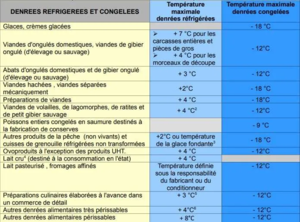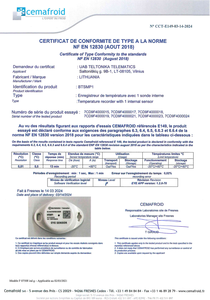BTSMP1 EN12830
EYE SENSOR EN12830
Effective control and monitoring of temperatures within the cold chain are crucial for maintaining the quality of goods. To guarantee optimal temperature conditions for food and pharmaceutical products and to ensure continuous monitoring, adherence to a set of standards must be met. European regulations require, among other things, the use of recorders that comply with the of standard called EN12830.
EYE Sensor EN12830 is a Bluetooth® Low Energy recorder that enhances business operations through certified temperature monitoring. This sensor holds an EN12830 certificate and delivers precise measurements with a 0.5°C accuracy class across all working ranges from -20°C to +60°C. Each temperature sensor is calibrated in an ISO 17025-certified laboratory to ensure reliability. Designed with a food-grade casing that complies with EU and FDA regulations for food contact applications, the EYE Sensor EN12830 is perfect for tracking perishables like dairy, meat, and pharmaceuticals. It also features internal memory capable of storing temperature readings for up to 345 days, ensuring compliant monitoring.
Scope of regulation
In a context of globalization, the storage, transport and distribution of heat-sensitive products are subject to different regulations depending on the country. This article will only deal with the subject of regulations on the European territory. There are many professions that have to comply with the regulations on cold chain traceability and you must make sure of the standards applicable to your branch of activity.
The text of the EN12830 standard gives an example of the fields of activity identified: “Examples of goods that are sensitive to transport, storage and distribution temperatures between -80 °C and +85 °C are refrigerated, frozen and deep-frozen goods, ice cream, fresh and hot food, pharmaceuticals, blood, organs, chemicals, biological materials, electronic and mechanical devices, flowers, plants, bulbs, raw materials and liquids, animals, works of art and furniture. »
The scope of application is very broad, but we focus on 2 major branches of activity in terms of transport and logistics covered by this regulation:
Storage and transport of chilled, frozen and deep-frozen perishable goods. Storage and transport of medical products: pharmaceuticals, blood products, organs and medical samples.
Technical information
| Resolution | class | Response time | Sensor temperature range |
|---|---|---|---|
| 0,01 °C | 0,5 °C | 13 min | from -20 °C to +60 °C |
Proprietary solution or open system?
There are many ways to deal with these security and integrity issues, but there are two main approaches:
The first is to ensure the security and integrity of the data through a proprietary system. In short, from the sensor to the data visualization application level. In this case, compliance with the standard is easier to achieve because it is handled at the application level, which has significant computing resources. Nevertheless, this approach requires the exclusive use of the entire manufacturer’s solution: from the temperature sensor to the final application through all the manufacturer’s own communication layers. The second is to ensure data security and integrity through an open system. The temperature sensor itself is designed to meet the security and integrity requirements imposed by the standard. In this case compliance with the standard is more difficult to achieve, as it requires that this be handled at the sensor level, which has limited computing resources. However, this way of doing things allows manufacturers to remain open to any independent system, while ensuring compliance with the EN12830 standard.
How do I know if a recorder complies with the EN12830 standard?
The manufacturer of your recorder must be able to issue a certificate of conformity in its own name. Furthermore, this equipment must have undergone conformity tests carried out by a COFRAC-accredited standardization laboratory. The manufacturer must be able to provide you with the test report from this COFRAC-accredited laboratory. Attention, it is your responsibility to check that the report refers to the standard in force: in this case the 2018 version of EN12830.
What temperature values must you observe?
The definition of the temperature values that you must respect depends on your sector of activity. To help you, if you are in the case of transport of perishable foodstuffs, the Ministry of Agriculture publishes a summary table of storage temperatures to be respected. You can download this documentation here.
Here is an excerpt from the document:
For the transport of pharmaceuticals, blood and samples the 3 most frequently used temperature values are as follows:
- 20°C (range 18 to 24°C)
- 4°C (range 2 to 8°C)
- – 20°C (range-30 to – 18°C).
It is quite frequent in this sector of activity that the recorders are certified for all 3 temperature values simultaneously, which inevitably increases the cost of certification. Attention, this is given for information only and it is important to check the requirements of your sector of activity.
What temperature accuracy do you have to respect?
The definition of the temperature accuracy you need to meet depends on your industry and your requirements. For example for the transport of perishable goods your recorder must be accurate to + or – 2°C. It must therefore be class 2 or better (Class 1 for example).
Concerning the transport of pharmaceutical and blood products the recorder temperature class requested and frequently class 1 (+ or – 1°C accuracy) in the negative temperature ranges and class 0.5 (+ or – 0.5°C accuracy) in the positive ranges.
Attachments
You can the find PDF version of the EN12830 Certification here.

